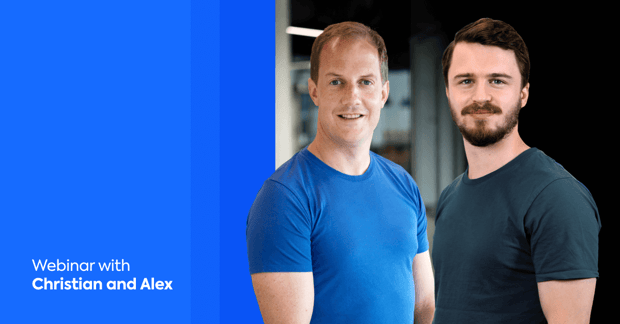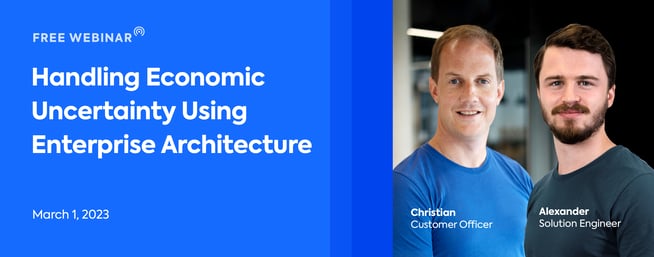
Economic uncertainty in the global market dominated 2022 and concerns about the economy persist. In our recent webinar, LeanIX Chief Customer Officer, Christian Richter explained how enterprise architecture management can help companies streamline costs and improve organizational agility.
Economic uncertainty remains at the top of the agenda in board meetings across all industries and "do more with less" is a common phrase. Enterprise architects have taken this to heart and have begun working diligently to apply this mindset to their IT landscape.
Pro-active enterprise architecture management (EAM) provides the toolset needed to get more done with a tech stack freed of redundancy and inefficiency.
In our recent webinar, our Chief Customer Officer, Christian Richter, and Solution Engineer, Alex Ettinger, explained how EAM can support efficiency in this climate. Below, we summarise the key points.
Watch a full recording of the webinar:
Handling Economic Uncertainty Using Enterprise Architecture
Enterprise architecture management: Key to managing risk and IT spend
Tech stacks tend to grow organically in response to changes in the business and the surrounding market environment. Enterprise architecture management (EAM) is the practice of bringing intentional order to your IT landscape.
Among other things, EAM allows you to streamline your software application portfolio, designing or architecting it to ensure consistent support for your business. In the process of implementing this architecture, you will inevitably prune away unused or unneeded applications. You will also upgrade or re-architect critical applications to deliver more value.
Before you can design an optimal architecture, let alone pursue any application rationalization or application modernization initiative, you need an accurate overview of your existing landscape.
IT leaders are demanding a strategic view
Leaders see this overview as essential for strategic planning in the face of economic uncertainty. To create it, you need to answer the following questions:
- What software applications do you own?
- What are they used for?
- Who uses them?
- How much do they cost?
- Are they updated to the latest version?
- When will individual applications become obsolete?
- Do they overlap in terms of function?
- Are you paying for two versions of the same thing?
- Do your applications have functionality that you aren't using?
Gathering this information can be time-consuming and, at times, challenging. Still, with the right EAM tool, you can quickly visualize your current landscape and begin creating a roadmap to a better, rationalized one.
To see what the LeanIX Enterprise Architecture Management tool can do, book a demo:
Inventorying your IT landscape in a live platform, rather than a static spreadsheet, means that your EAM solution continues to produce value beyond the initial inventory process.
Long after you've completed your first rationalization process, your EAM platform will continue to reveal:
- when software updates are needed
- what new applications have been added
- what applications have become obsolete
- when your colleagues have abandoned a tool or started using an alternative
This is crucial for avoiding unnecessary expenditure on your IT landscape at a time when every invoice counts.
Enterprise architecture management challenges
Getting an efficient and effective EAM program off the ground is not always easy. In fact, you may find a number of potential obstacles in your path. These could include:
Buy-in
Persuading colleagues to support and engage with the inventory and rationalization process can be difficult. Your team may be reluctant to abandon a tool they are accustomed to. This is especially the case when the value of application rationalization has not been made clear.
Identifying Dependencies
Your application portfolio is not just a selection of independent apps. It's more like a house of cards ready to fall down if the wrong card is removed. Identifying the downstream dependencies of applications takes time and accurate data. This becomes even more challenging when your goals include both application reduction and application license reduction.
Execution
It's one thing to decide to sunset an application. Actually doing so is another thing and can require a challenging migration process. It's often far too easy to delay the follow-through on your application rationalization, sometimes indefinitely.
Training
Switching to a new application or optimizing the use of an existing one requires large-scale reskilling of your colleagues. This will likely involve collaboration beyond your jurisdiction and, of course, involves costs of its own.
5 steps to navigating economic uncertainty with enterprise architecture management
So, how can you overcome these challenges and use enterprise architecture management to prepare your business to survive and thrive through economic uncertainty? Here are five steps you can take.
1. Business capability mapping
Why do you have applications? To support your business processes. Understanding what business processes are supported by what apps – and to what extent these applications do that successfully – will immediately make it clear which apps you need and which you don't.
Thankfully, you don't have to collect all the relevant data on your own. "Socializing" the process allows you to crowdsource this information from your colleagues.
In addition to collecting data on your application, it helps to categorize both capabilities and applications in terms of whether they help differentiate you from your competitors or enable innovation. If they don't do either, chances are they are a commodity – online storage or even AP/AR systems could fall into this category.
Applying such a framework lets you make strategic technology investments. Differentiation and innovation, obviously, deserve all the resources they can get. Your choice of commodity software, on the other hand, can be driven primarily by cost concerns..
The bottom line is that viewing your application portfolio through the lens of business capabilities enables decision making based on business strategy, rather than habit or the inclinations of specific stakeholders.
2. Application 360-degree view
Mapping your applications to business capabilities is a great start, but you need more information than that. You need a complete, 360-degree view of your application portfolio and how each app interconnects and interactsz with the landscape.
This is where your organization comes in. Speak to your team about each application and determine:
- Ownership
- Cost
- Usage
- Dependencies
- Fit (both functional and technical)
When you've documented all of this information, you should have a complete overview of your IT landscape and be ready to start making strategic application rationalization decisions.
The best way to document your application landscape is to use the best-practice tools and visualizations pre-built into the LeanIX enterprise architecture management platform.
To find out more, book a demo:
3. Application rationalization
Once you have a full view of your application landscape, you can start making decisions about which applications you keep and which you retire. Still, even in times of economic uncertainty, this exercise isn't only about reduction. You are also looking for critical gaps to be filled.
A business capability map will clearly show where multiple applications support the same capability. It will also show where capabilities are under supported. In this latter case, it might not mean you need to buy something new. There's always the possibility that you already own something that could be covering more capabilities than it currently does.
When you find redundancies or gaps, you need to decide what to do about. The answer isn't always "shut it off." The TIME framework created by Gartner provides a more nuanced way of deciding on next steps. TIME stands for:
- Tolerate - leave the application in place, even if it's not optimal
- Invest - expand your use of a vital application
- Migrate - move your application to a better location in your IT landscape
- Eliminate - put together a plan to sunset your application
Once you've sorted your applications, you can begin formulating an enterprise architecture management roadmap for those you intend to invest in, migrate, or retire. This is where the hard work begins: persuading stakeholders of the value of this initiative and the soundness of your decisions.
4. Advocate for rationalization
Change management is always difficult, particularly during times of uncertainty. Our instinct in tough times is to hold onto what we know.
The key to reducing anxiety about change is clarity. Visualize your IT landscape for stakeholders, showing clearly the reason for your decision as well as the roadmap for what happens next.
Be prepared for compromise but also escalation in case of blockers or conflicts. Once again, having a clear visualization of your roadmap acting as a single, accessible source of truth will be vital for achieving consensus.
5. Use the right enterprise architecture management platform
The LeanIX Enterprise Architecture Management platform was designed to give you the detailed overview of your application landscape that you need to:
- map your application landscape
- roadmap your plan for transformation
- win support from internal stakeholders
- adopt a culture of continuous transformation into the future
To find out more about the LeanIX enterprise architecture management platform, book a demo today.






